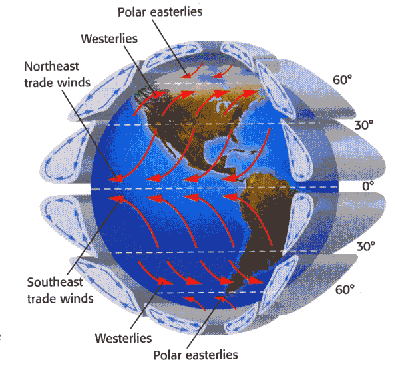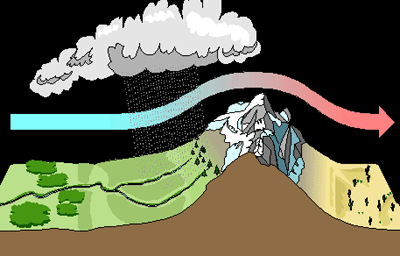The source of energy that drives all significant evaporation and subsequent precipitation is the sun. The sun is the engine that drives the water cycle, but the sun does not heat the entire surface of the Earth evenly. The equator receives more solar radiation year round than any other area on the Earth. This difference in heating leads to the formation of zones of alternating wet and dry zones called Hadley Cells.
The picture to the right illustrates this.
At the equatorial zone, the sun causes massive evaporation and this water vapor in turn condenses and falls back to Earth as it makes its way away from the equator. The falling of this heavy, water-laden air plus the rotation of the Earth contributes to the wind patterns listed on the illustration.
At the zone around 30 degrees (north and south), the air has lost most of its moisture and this is where we find the large majority of the major deserts, the Sahara, Arizona, etc. In the latitudes between 30 degrees and 60 degrees, wind patterns conspire again to create more rain rich areas, with the Polar Regions comprising another desert region.
As a side note, you can see that Florida actually falls in this desert zone but our close proximity to ocean on three sides keeps us with plenty of moisture. So obviously, there's more than just Hadley Cells at work.


Another factor in rainfall patterns and specifically in desert formation is the phenomenon of rain shadow.
The picture to the left illustrates this.
As heavy, moisture laden air meets a large typographical feature such as a mountain range, the air is forced upward where the temperature and air pressure change. As the temperature gets cooler and the pressure lessons, the air looses its ability to hold water vapor and the stored moisture falls out as rain or snow. The air on the other side of the mountain range is therefore devoid of moisture and the lands beyond it will see little rain.
A good example of this effect are the deserts of the Andes mountains. Some of these deserts are no further away from the ocean than parts of Florida are, but the rain shadow caused by the Andes Mountains creates some of the driest lands on Earth.
Another good example of this effect is seen in India. As air comes in off of the Indian Ocean, it encounters the Himalayan Mountains and dumps its moisture onto the rain forests of southeast Asia. The Himalayan Plateau beyond receives very little rainfall in comparison.
